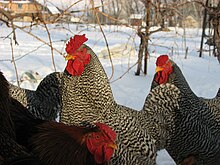
Dominique chicken
 Six-month-old cockerel, center | |
| Conservation status | |
|---|---|
| Other names |
|
| Country of origin | United States |
| Use | Dual-purpose, eggs and meat |
| Traits | |
| Weight |
|
| Skin color | yellow |
| Egg color | brown |
| Comb type | rose |
| Classification | |
| APA | American[4] |
| ABA | rose comb, clean legged[5]: 53 |
| EE | recognised[6] |
| PCGB | rare soft feather: heavy[7] |
| |
The Dominique is an American breed of chicken, characterized by black-and-white barred plumage and a rose comb. It is considered to be the oldest American chicken breed,[8]: 121 and is thought to derive from birds brought to America by colonists from southern England. It was well known by about 1750, and by the mid-nineteenth century was widely distributed in the eastern United States.[9]: 429 [5]: 53 It is a dual-purpose breed, but is kept principally for its brown eggs.[9]: 429 It became an endangered breed in the twentieth century, but numbers have since recovered.[2]

History
The origins of the Dominique are unknown.[10] It is considered to be the oldest American chicken breed,[8]: 121 and is thought to derive from birds – probably similar to the modern Dorking or Sussex breeds – brought to America by colonists from southern England. Chickens with barred plumage, with either a single or a rose comb, were well known by about 1750, and by the mid-nineteenth century were widely distributed in the eastern United States.[5]: 53 [9]: 429 They were known by many names – among them Blue Spotted Hen, Dominic, Dominicker, Dominico, Old Grey Hen and Pilgrim Fowl – but were commonly known as Dominique. Some of the earliest books on poultry include these as a valuable American breed.[11]: 97 Some were exhibited at the first American poultry show, held in Boston in 1849.[9]: 429

In the 1860s the Plymouth Rock was created by cross-breeding Black Java with large single-combed Dominiques; it was first exhibited in 1869.[2] It was rather larger than the Dominique, but otherwise fairly similar. At a poultry show in New York in 1870, the organisers ruled that only rose-combed barred birds could be exhibited as Dominiques; those with single combs were to be entered as Plymouth Rocks.[2][9]: 429 In 1871 this ruling was confirmed in a Standard of Excellence for the Dominique.[9]: 429 In 1874 the Dominique was included in the first edition of the American Standard of Perfection of the new American Poultry Association;[2] the Dominique bantam was added in 1960.[4]: 6

Breed numbers declined during the twentieth century, and by the 1970s the Dominique was close to disappearing. A recovery initiative was launched, and from 1983 numbers began to rise again.[2] Until about 2003 its conservation status was listed as "critical" by the American Livestock Breeds Conservancy (now the Livestock Conservancy), with fewer than 500 breeding birds in North America.[12] In 2021 it was listed as "watch" by the Livestock Conservancy, and was reported to DAD-IS as "not at risk".[2][3]

Characteristics


The Dominique is of medium size, mature birds usually weighing some 5–7 lb (2.3–3.2 kg). The only recognized plumage coloration is cuckoo, sometimes known as "hawk" coloration, a regular pattern of light and dark – but not black and white – barring.[2]

The head is carried high, and has a rose-comb with a single backwards-pointing spike; the earlobes and wattles are red, and the beak yellow.[2] The legs and feet are also yellow.[13]: 7

The plumage is held fairly tight to the body; because of this and the rose comb, it has better resistance to frostbite than some other breeds.[2]

Use
The Dominique is a dual-purpose breed, but is kept principally for its brown eggs,[9]: 429 of which hens lay about 200 per year, with an average weight of 58 g.[10]: 33

References
- ^ Barbara Rischkowsky, Dafydd Pilling (editors) (2007). List of breeds documented in the Global Databank for Animal Genetic Resources, annex to The State of the World's Animal Genetic Resources for Food and Agriculture. Rome: Commission on Genetic Resources for Food and Agriculture, Food and Agriculture Organization of the United Nations. ISBN 9789251057629. Archived 23 June 2020.
- ^ a b c d e f g h i j Dominique Chicken The Livestock Conservancy. Archived 26 January 2021.
- ^ a b Breed data sheet: Dominique / United States of America (Chicken). Domestic Animal Diversity Information System of the Food and Agriculture Organization of the United Nations. Accessed January 2022.
- ^ a b APA Recognized Breeds and Varieties: As of January 1, 2012. American Poultry Association. Archived 4 November 2017.
- ^ a b c Carol Ekarius (2007). Storey's Illustrated Guide to Poultry Breeds. North Adams, Massachusetts: Storey Publishing. ISBN 9781580176675.
- ^ Liste des races et variétés homologuée dans les pays EE (28.04.2013). Entente Européenne d’Aviculture et de Cuniculture. Archived 16 June 2013.
- ^ Breed Classification. Poultry Club of Great Britain. Archived 12 June 2018.
- ^ a b J. Ian H. Allonby, Philippe B. Wilson (editors) (2018). British Poultry Standards: complete specifications and judging points of all standardized breeds and varieties of poultry as compiled by the specialist breed clubs and recognised by the Poultry Club of Great Britain, seventh edition. Chichester; Hoboken, New Jersey: Wiley Blackwell. ISBN 9781119509141.
- ^ a b c d e f g Janet Vorwald Dohner (2001). The Encyclopedia of Historic and Endangered Livestock and Poultry Breeds. New Haven, Connecticut; London: Yale University Press. ISBN 0300088809.
- ^ a b Rassetafeln: Hühner (in German). Reichenbach, Haselbachtal: Bund Deutscher Rassegeflügelzüchter. Accessed January 2022.
- ^ Victoria Roberts (2008). British Poultry Standards: complete specifications and judging points of all standardized breeds and varieties of poultry as compiled by the specialist breed clubs and recognised by the Poultry Club of Great Britain, sixth edition. Oxford: Blackwell. ISBN 9781405156424.
- ^ Conservation Priority List. American Livestock Breeds Conservancy (now The Livestock Conservancy). Archived 1 June 2003.
- ^ Mark A. Fields (February 25, 2015). https://dominiqueclub.org/wp-content/uploads/2015/12/Interpreting-the-Dominique-Standard.pdf Interpreting The Dominique Standard in 2015]. Dominique Club of America. Accessed February 2022.
Further reading
- Tamara Staples, Ira Glass, Christa Velbel (2001). The Fairest Fowl: Portraits of Championship Chickens. San Francisco: Chronicle Books. ISBN 9780811831376.

See what we do next...
OR
By submitting your email or phone number, you're giving mschf permission to send you email and/or recurring marketing texts. Data rates may apply. Text stop to cancel, help for help.
Success: You're subscribed now !
